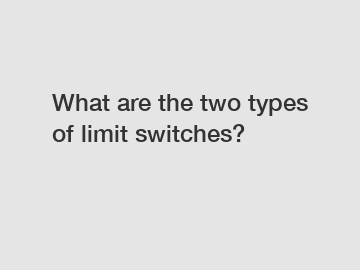What are the two types of limit switches?
Limit switches are a crucial component in many industrial and manufacturing applications, providing a way to detect the presence or absence of an object or control the movement of equipment. There are two main types of limit switches: mechanical limit switches and proximity limit switches. Each type has its own unique characteristics and uses in different types of machinery and equipment. Understanding the differences between these two types of limit switches can help you choose the right one for your specific application.
Mechanical Limit Switches.
Mechanical limit switches are the more traditional type of limit switch and are still widely used in many industrial applications. These switches use physical mechanisms, such as levers, plungers, or rollers, to make contact with an object and trigger a response. When the object comes into contact with the switch, it actuates the mechanism, which in turn sends a signal to the control system to stop, start, or change the movement of equipment.

One of the key advantages of mechanical limit switches is their simplicity and durability. These switches are usually designed to withstand harsh industrial environments and can last for a long time without needing maintenance or replacement. They are also easy to install and can be used in a wide range of applications, from simple on/off control to more complex positioning and sequencing tasks.
Proximity Limit Switches.
Proximity limit switches, on the other hand, are a more modern type of limit switch that use non-contact sensing technology to detect the presence or absence of an object. Instead of physical mechanisms, proximity switches use electromagnetic, ultrasonic, or optical sensors to detect objects at a distance. When an object enters the sensing range of the switch, it triggers a response without the need for physical contact.
One of the main advantages of proximity limit switches is their versatility and flexibility. These switches can be used in a wide range of applications where physical contact is not possible or desirable, such as in hazardous or sterile environments. Proximity switches are also more precise and accurate than mechanical switches, making them ideal for applications that require high levels of precision and repeatability.
Choosing the Right Limit Switch.
When choosing between mechanical and proximity limit switches, it's important to consider the specific requirements of your application. Mechanical switches are best suited for applications that require simple, robust, and cost-effective solutions, while proximity switches are more suitable for applications that require non-contact sensing, high precision, and flexibility.
In conclusion, mechanical and proximity limit switches are two main types of limit switches that are used in industrial and manufacturing applications to detect the presence or absence of an object and control the movement of equipment. Each type has its own unique characteristics and uses, and understanding the differences between them can help you choose the right one for your specific application.
If you have any questions about limit switches or need help choosing the right one for your application, please feel free to contact us. Our team of experts is here to help you find the best solution for your needs.
If you want to learn more, please visit our website Micro Switch China, One-way Top-roller Lever Limit Switch Price, Cats Whisker Lever Limit Switch Price.
171
0
0

Comments
All Comments (0)